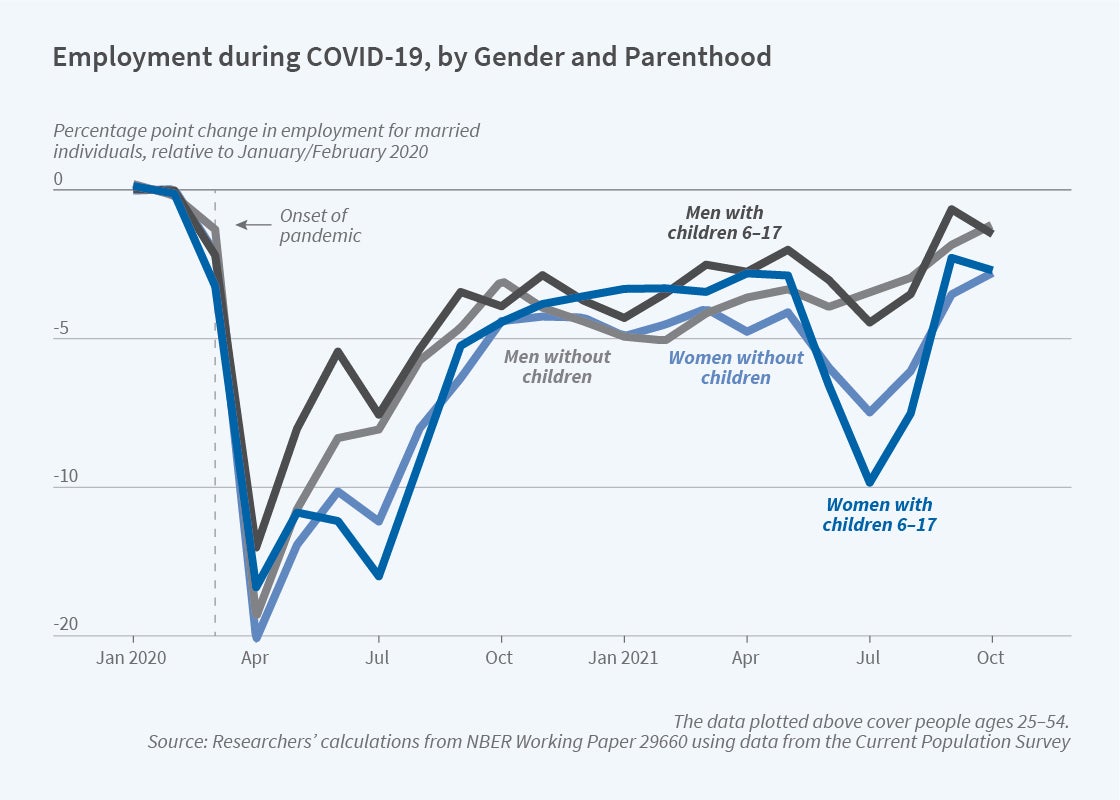Pandemic School Closures and Parents’ Labor Supply

Two new studies show that school closures caused by the COVID-19 pandemic significantly reduced parents’ labor market activity. They reach different conclusions about which demographic groups were most affected, one concluding that it was parents without college degrees, the other pointing to mothers with school-aged children. These disparities may be the result of the studies’ analysis of somewhat different time periods and geographic areas.
In The Impact of School and Childcare Closures on Labor Market Outcomes during the COVID-19 Pandemic (NBER Working Paper 29641), Kairon Shayne D. Garcia and Benjamin W. Cowan report that parents, especially those without college degrees, responded to school closures by reducing their hours or shifting from full- to part-time work. They concentrate on the period from August 2020 to April 2021 because it covers the height of the pandemic and the first full academic term for which many schools switched to remote learning. Their study draws on cellphone data of foot traffic to pinpoint school closures, and on the Basic Monthly Current Population Survey for labor-supply information.
Hours worked declined for parents without college degrees but not for those with them, and childcare duties fell more heavily on mothers.
School closures were associated with a 3.8 percentage point decline in full-time work by mothers and a 2.5 percentage point decline by fathers, with the reductions primarily resulting from transitions to part-time work. Mothers on average worked 1.3 fewer hours a week and fathers 1.5 fewer hours. Parents without a college degree worked about two hours less per week, while those with college degrees showed negligible declines. Some studies of the early months of the pandemic — prior to the period considered in this study — found larger reductions in labor supply for mothers than for fathers, possibly because as the pandemic evolved, fathers pitched in more. Among unmarried parents, women were more likely than men to shift to part-time work; reductions in hours worked were comparable across genders. School closings were not associated with changes in labor supply among those who were not parents. The researchers explain the disparities across education groups by suggesting that more-educated workers were more likely to shift to working from home and to have access to alternative childcare arrangements or private schooling.
While Garcia and Cowan study changes in labor supply when schools close, Benjamin Hansen, Joseph J. Sabia, and Jessamyn Schaller also consider changes when they reopen. In Schools, Job Flexibility, and Married Women’s Labor Supply: Evidence from the COVID-19 Pandemic (NBER Working Paper 29660), which also analyzes data from the Current Population Survey, they cover a broader time frame, September 2019 to October 2021. Their study spans all three academic years that were affected by the pandemic. It also includes a somewhat larger geographic area, with more rural locations, than the other study. The results suggest that in-person K-12 schooling was associated with employment gains for married women with school-aged children, but not for any other group, including single mothers and married custodial fathers.
After schools reopened, married women with school-aged children reported a 3.3 percentage point increase in employment and a 3.3 percentage point decline in remote work. The figures exclude women who were employed in the K-12 educational sector.
Mothers with and without college degrees showed comparable employment gains after schools reopened. Educational attainment, however, was a significant factor in work patterns. Mothers who completed college reduced remote work by 4.4 percentage points, versus a statistically insignificant 1.4 percentage point decline for those with less education.
The age of children made a difference. Mothers of children aged 12 to 17 saw a 3.9 percentage point increase in employment, compared with 2.5 percentage points for those with children aged 6 to 11. The decline in remote work was almost entirely among the mothers of the younger children. The researchers suggest that mothers with younger children may seek out jobs with greater flexibility, and that those with older children may have decided to leave the labor force when schools went remote in order to make sure that students kept up their grades.
— Steve Maas


